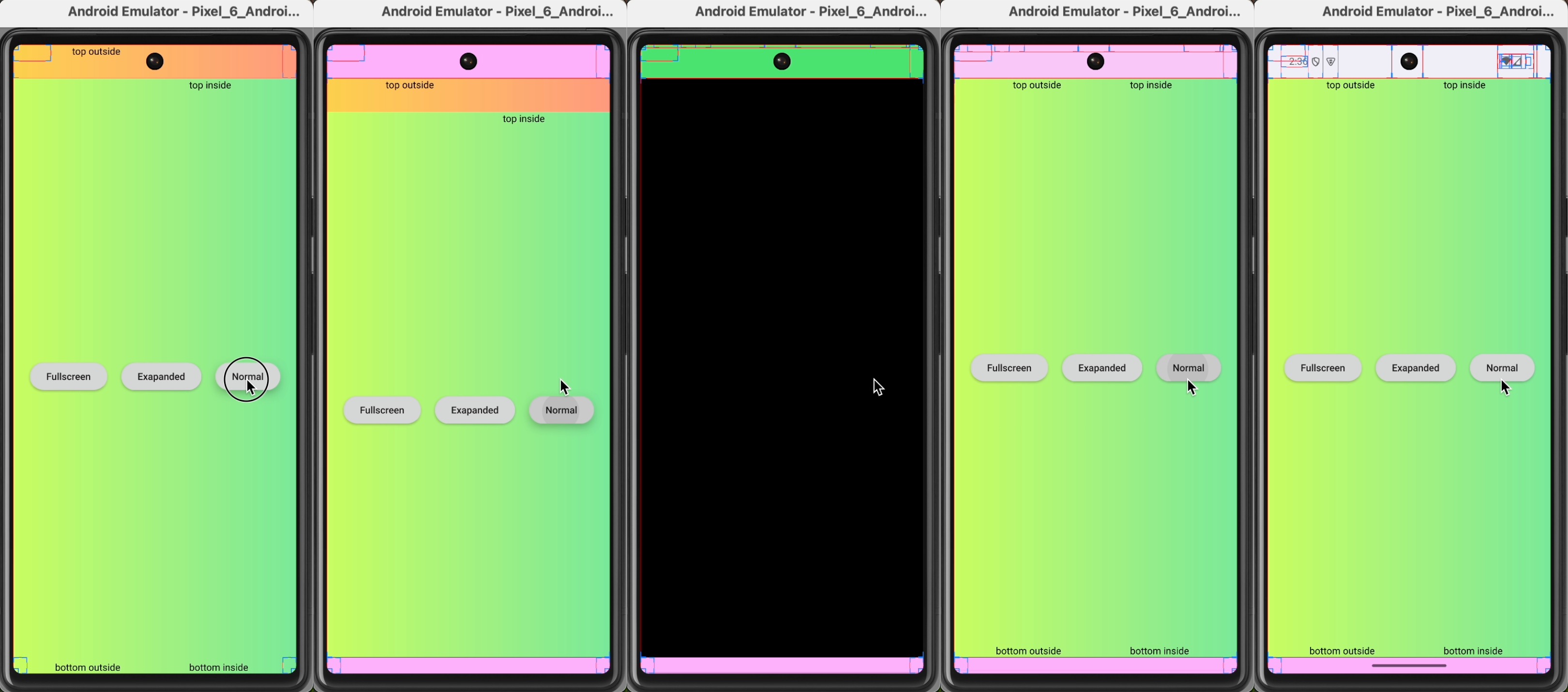-
 Technical task
Technical task
-
Resolution: Unresolved
-
P1: Critical
-
None
-
None
-
-
2025wk02s3FOQtforAndroid, 2025wk04s3FOQtforAndroid, 2025wk06s1QtforAndroid, 2025wk08s1QtforAndroid, 2025wk16s1QtforAndroid, 2025wk22s1-2QtforAndroid, 2025wk28s2QtforAndroid, 2025wk38s2QtforAndroid, 2025wk40s2-3QtforAndroid, 2025wk42s3QtforAndroid, 2025wk44s3QtforAndroid
-
7344d21c7 (dev), 2c40e9b91 (dev), 9ba94b1e6 (dev), d25064b04 (dev), 65c41c6be (dev), 7dcf58eed (dev)
When changing the system UI visibility (hiding/showing status and navigation bars) there's a noticeable flicker and sizing artifacts throughout that transition, notably going from normal ↔ fullscreen or vice versa.
The issue seems to be related to wrong sizing times (too early or too late for the system ui animation) and wrong intermediate sizes.
The transitions can be seen as follows for normal to fullscreen:

Here it's for example noticeable that sometimes the size is smaller than the actual the size while the app's actual geometry is bigger and that cause the Qt content to be shifted up (top part is below the status bar that's being hidden).
and from fullscreen to normal:

There could as be issues or races between setting the screen's geometry and the newly available geometry and the window's geometry.
For reproduction use fullscreen-transition-flicker-bug.zip![]() .
.
Places to look at:
- QAndroidPlatformWindow::updateSystemUiVisibility() and QtDisplayManager.setSystemUiVisibility()
- QtLayout.onMeasure() and QtLayout.onLayout()
- QtRootLayout.onSizeChanged()
- androidjnimain.cpp:setDisplayMetrics()
- QAndroidPlatformScreen::setAvailableGeometry()
Similar or duplicate tickets:
Outcome
This would be done when such system ui changes cause no flicker and no rendering artifacts.
Make sure this still works for https://github.com/qt/qtdoc/tree/6.9/examples/demos/windowembedding.
| For Gerrit Dashboard: QTBUG-132720 | ||||||
|---|---|---|---|---|---|---|
| # | Subject | Branch | Project | Status | CR | V |
| 680263,7 | Android: don't recreate a new ANativeWindow on size change | dev | qt/qtbase | Status: NEW | +2 | 0 |
| 680265,7 | Android: set native QtWindow's geometry gracefully | dev | qt/qtbase | Status: NEW | +2 | 0 |
| 614930,7 | Android: don't run setSystemUiVisibility with same params | dev | qt/qtbase | Status: MERGED | +2 | 0 |
| 614931,7 | Android: don't call requestLayout() under setSystemUiVisibility() | dev | qt/qtbase | Status: MERGED | +2 | 0 |
| 614938,7 | Android: don't touch system bars colors in fullscreen | dev | qt/qtbase | Status: MERGED | +2 | 0 |
| 615249,8 | Android: get rid of default screen sizes and physical size | dev | qt/qtbase | Status: MERGED | +2 | 0 |
| 615254,10 | Android: don't pass x/y dpi values to setDisplayMetrics() | dev | qt/qtbase | Status: MERGED | +2 | 0 |
| 615256,13 | Android: separate setting screen size from setDisplayMetrics() | dev | qt/qtbase | Status: MERGED | +2 | 0 |

